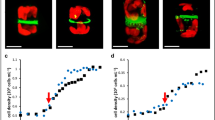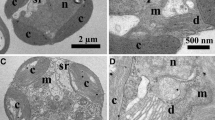Summary
The vacuoles of the sieve elements ofSelaginella kraussiana contain a crystalline protein which appears to degenerate in mature cells. Although it occurs in sieve elements we have elected not to call it “P-protein” because of ontogenetic and possibly functional differences between the two. The nucleus undergoes unique structural changes during development of the sieve element, ultimately being converted to a mass of tubules. The structures referred to by earlier workers as “refractive spherules” inSelaginella are probably plastids. As the size of the sieve pores in lateral and end walls falls into the same size range, the sieve elements ofSelaginella kraussiana can be considered to be sieve cells.
Similar content being viewed by others
References
Bouck, B., andJ. Cronshaw, 1965: The fine structure of differentiating sieve tube elements. J. Cell Biol.25, 79–96.
Buvat, R., 1963: Les infrastructures et la différenciation de cellules criblées deCucurbita pepo L. Portugal. Acta Biol. Ser. A7, 249–299.
Cronshaw, J., andR. Anderson, 1969: Sieve plate pores ofNicotiana. J. Ultrastruct. Res.27, 134–148.
— andK. Esau, 1968: P protein in the phloem ofCucurbita. I. The development of P-protein bodies. J. Cell Biol.38, 25–39.
Duerden, H., 1934: On the occurrence of vessels inSelaginella. Ann. Bot.48, 459–466.
Esau, K., 1969: The phloem. In: Handbuch der Pflanzenanatomie (W. Zimmermann, P. Ozenda, H. D. Wulff, eds.). Histologie, Vol.5, pt. 2. Berlin-Stuttgart: Borntraeger.
—, 1972: Changes in the nucleus and the endoplasmic reticulum during differentiation of a sieve element inMimosa pudica L. Ann. Bot.36, 703–710.
—, andR. H. Gill, 1971: Aggregation of endoplasmic reticulum and its relation to the nucleus in a differentiating sieve element. J. Ultrastruct. Res.34, 144–158.
Evert, R. F., J. D. Davis, C. M. Tucker, andF. J. Alfieri, 1970: On the occurrence of nuclei in mature sieve elements. Planta (Berl.)95, 281–296.
—,W. Eschrich, andS. E. Eichhorn, 1973: P-protein distribution in mature sieve elements ofCucurbita maxima, Planta (Berl.)109, 193–210.
Harvey-Gibson, R. J., 1894: Contributions towards a knowledge of the anatomy of the genusSelaginella Spr. I. The stem. Ann. Bot.8, 132–206.
Hume, E. M. M., 1912: The histology of the sieve tubes ofPteridium aquilinum, with some notes onMarsilea quadrifolia andLygodium dichotomum. Ann. Bot.26, 573–587.
Lamoureux, C. H., 1961: Comparative studies on phloem of vascular cryptogams. Diss. Univ. Calif., Davis.
Maxe, M., 1964: Aspects infrastructuraux des cellules criblées dePolypodium vulgare (Polypodiacée). C. R. Acad. Sci.258, 5701–5704.
—, 1966: Étude de la dégénérescence nucleaire dans les cellules criblées dePolypodium vulgare (Polypodiacée). C. R. Acad. Sci.262, 2211–2214.
Ogura, Y., 1938: Anatomie der Vegetationsorgane der Pteridophyten. In: Handbuch der Pflanzenanatomie (K.Linsbauer, ed.). Abt. 2, Teil 2. Archegoniaten, Band 7, Lief. 36, pp. 199–203.
Spurr, A. R., 1969: A low-viscosity epoxy resin embedding medium for electron microscopy. J. Ultrastruct. Res.26, 31–43.
Srivastava, L. M., andT. P. O'Brien, 1966: On the ultrastructure of cambium and its vascular derivatives. II. Secondary phloem ofPinus strobus L. Protoplasma61, 277–293.
Stiles, W., 1910: The structure of the aerial shoots ofPsilotum flaccidum Wall. Ann. Bot.24, 373–387.
Strasburger, E., 1891: Über den Bau und die Verrichtungen der Leitungsbahnen in den Pflanzen. Histologische Beiträge, Vol. 3. Jena: Gustav Fischer.
Terletzki, P., 1884: Anatomie der Vegetationsorgane vonStruthiopteris germanica Willd. undPteris aquilina L. Jb. wiss. Bot.15, 452–501.
Thomae, K., 1886: Die Blattstiele der Farne. Ein Beitrag zur vergleichenden Anatomie. Jb. wiss. Bot.17, 99–161.
Thair, B. W., andA. B. Wardrop, 1971: The structure and arrangement of nuclear pores in plant cells. Planta (Berl.)100, 1–17.
Vian, B., etJ.-C. Roland, 1972: Différenciation des cytomembranes et renouvellement du plasmalemme dans les phénomènes de sécrétions végétales. J. Microsc.13, 119–136.
Wrigley, N. G., 1968: The lattice spacing of crystalline catalase as an internal standard of length in electron microscopy. J. Ultrastruct. Res.24, 454–464.
Author information
Authors and Affiliations
Additional information
This work was supported by the U.S. National Science Foundation (GB 31417).
Rights and permissions
About this article
Cite this article
Burr, F.A., Evert, R.F. Some aspects of sieve-element structure and development inSelaginella kraussiana . Protoplasma 78, 81–97 (1973). https://doi.org/10.1007/BF01281524
Received:
Issue Date:
DOI: https://doi.org/10.1007/BF01281524




